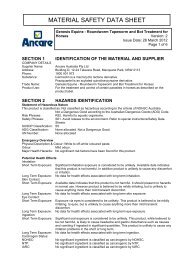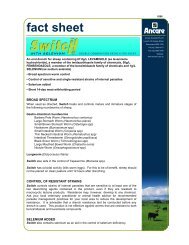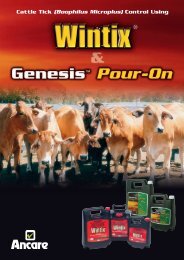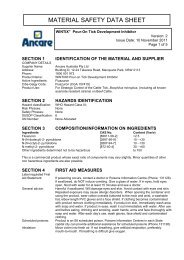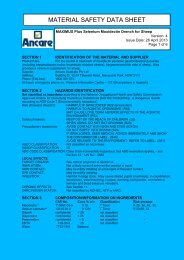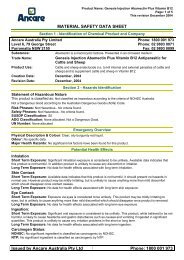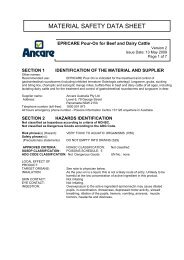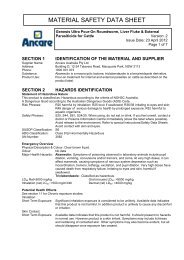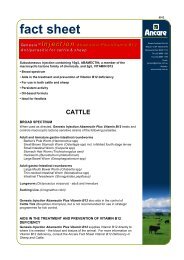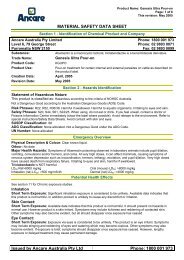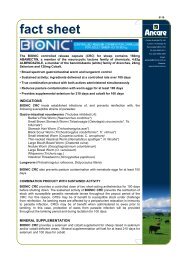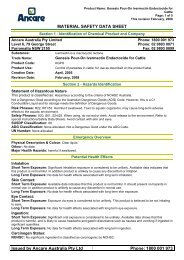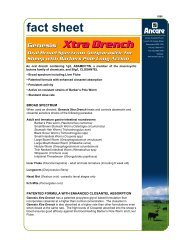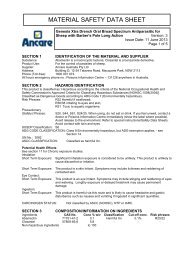GENESIS DRENCH with Selenium MSDS - Ancare
GENESIS DRENCH with Selenium MSDS - Ancare
GENESIS DRENCH with Selenium MSDS - Ancare
- No tags were found...
Create successful ePaper yourself
Turn your PDF publications into a flip-book with our unique Google optimized e-Paper software.
SECTION 11Genesis Drench <strong>with</strong> <strong>Selenium</strong> Oral Antiparasitic for SheepVersion: 3Issue Date: 31 May 2013Page 5 of 5TOXICOLOGICAL INFORMATIONPossible routes of exposure Ivermectin ingredient (not the product)LD50 acute oral rat:50 mg/kgLD50 acute dermal rat: >660 mg/kgInhalation 4 hr rat:5.11 mg/LSkin irritation (rabbit): Skin irritantEye irritation (rabbit):Eye irritantSensitisation (guinea pig): Not a sensitising agentGenotoxicityNot genotoxicThe ingredient ivermectin is classified as a reproductive toxicant (category 2).LOCAL EFFECTS OF PRODUCT: May be irritant to eyes and skin.TARGET ORGANS:Eyes, Skin.HAZARDOUS INGREDIENTS: Ivermectin R-phrases: 61/64/28/24/50.MUTAGENICITY DATA:Negative in Ames test. Negative in mouse lymphoma mutationassay. Does not induce unscheduled DNA synthesis in humanfibroblast cell culture.Subacute to chronic toxicity:No data is available regarding sub-chronic or reproductive effects ofthe product.Additional toxicological information: Ivermectin is believed to bind to glutamate-gated chloride ionchannels; avoid drugs that also interact <strong>with</strong> other ligand-gatedchloride channels, including those which enhance GABA activity inpatients <strong>with</strong> potentially toxic ivermectin exposure. Reproductivetoxicant in rabbits and mice.Symptoms which may occur:Over-exposure to ivermectin may cause dilated pupils,incoordination, drowsiness, depressed motor activity, slowedbreathing, dilation of pupils, tremors, vomiting, anorexia, muscletremors, headache or dizziness.No other ingredient classified as a Hazardous Substance in the HSIS is present at hazardous concentrations.Sodium selenite is present at a concentration below the classification cut-off.SECTION 12Ivermectin:Bioaccumulation potential:TOXICITY TO FISH:TOXICITY TO DAPHNIA:TOXICITY TO ALGA:TOXICITY TO BACTERIA:READY BIODEGRADABILITY: Not availableEnvironmental Fate:ECOLOGICAL INFORMATIONVery toxic to certain aquatic species.LC50 - Daphnia magna, 48 hours = 0.025 ppb; NOEL D. magna = 0.01 ppb;LC50 - Rainbow trout, 96 hours = 3.0 ppb;LC50 - Bluegill sunfish, 96 hours = 4.8 ppb.Does not bioaccumulateLC50 = 0.3 ug/L - Rainbow Trout - very toxic to fish.EC50 48 hr = 0.025 ug/L (D. magna) - very toxic.Not availableNot availableIvermectin photodegrades rapidly in the environment and is metabolized inthe soil. Water solubility is limited and it binds to soil very tightly. It does notbioconcentrate in fish and is not taken up from soil to plants. Both aquaticand terrestrial studies confirm rapid degradation of ivermectin in theenvironment, and lack of accumulation and persistence.Do not contaminate dams, rivers or streams <strong>with</strong> product or empty containers.



